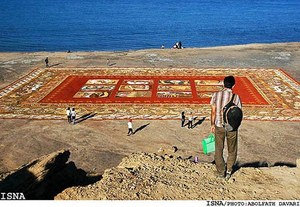Sand carpets, however, originate far earlier than their Corpus Christi cousins and the colours and symbol meanings go far deeper than just mere decoration. From the earliest times of mankind's existence we used art to represent and beautify our environment, take cave paintings for instance. As mankind settled into communities art became more elaborate and decorative but symbolism always played the most important part in our arts and crafts. Our ancestors had a firm belief that each symbol held specific powers and when these symbols were embellished or painted or tattooed, it would pass these special powers onto the wearer. Symbols of protection were commonly used in clothing and home decor and special protection and healing ceremonies were held by using these symbols, often in sand paintings or textiles wrapped around the person. Thus the first carpets were not of wool but of sand, the body of our earth (and dust we are and to dust we shall return), and their purpose was for healing, protecting and blessing those that walked onto it. This has not changed because each symbol on a Persian carpet still carries with it these wishes for healing protection and blessings albeit in a far more commercial setting.
Our ancestors understood that every element of earth has certain powers that can assist mankind in various ways. Indigenous Australian art has a history which covers more than 30,000 years, and a wide range of native traditions and styles. These have been studied in recent decades and their complexity has gained increased international recognition. Aboriginal Art covers a wide variety of media, including sand painting, Art is one of the key rituals of Aboriginal culture. It was and still is, used to mark territory, record history, and tell stories about "The Dreaming".
In the sand painting of southwestern Native Americans (the most famous of which are the Navajo (known as the Diné)), the Medicine Man (or Hatałii) paints loosely upon the ground of a hogan, where the ceremony takes place, or on a buckskin or cloth tarpaulin, by letting the coloured sands flow through his fingers with control and skill. There are 600 to 1,000 different traditional designs for sand paintings known to the Navajo. They do not view the paintings as static objects, but as spiritual, living beings to be treated with great respect. More than 30 different sand paintings may be associated with one ceremony.
Tibetan Buddhist sand paintings usually composed mandalas. In Tibetan, it is called dul-tson-kyil-khor (mandala of coloured powders). The sand is carefully placed on a large, flat table. The construction process takes several days, and the mandala is destroyed shortly after its completion. This is done as a teaching tool and metaphor for the "impermanence" (Pali: anicca) of all contingent and compounded phenomena (Sanskrit: Pratītya-samutpāda).
From the 15th century in Japan, Buddhist artists in the times of the shōguns practised the craft of bonseki by sprinkling dry coloured sand and pebbles onto the surface of plain black lacquered trays. They used bird feathers as brushes to form the sandy surface into seascapes and landscapes. These tray pictures were used in religious ceremonies. Japanese esoteric Buddhism was transmitted from East Central Asia after the 8th century, and thus these Japanese Buddhist sand paintings may share earlier historical roots with the more intricate brightly coloured Buddhist sand mandalas created by Tibetan Buddhist monks.
During the 17th and 18th centuries, the royal courts of Europe employed "table deckers", who decorated the side tables at royal banquets having adapted the craft of 'bonseki' from the Japanese. The table deckers sprinkled coloured sands, marble dust, sugars, etc. upon the surface of plain white tablecloths to create unfixed pictures of fruit, flowers, birds and rustic scenery. In between each design spaces were left for fruit bowls and sweetmeat dishes so that the diners could refresh themselves in between the main courses of the feast. These ornate pictures were discarded along with the debris of the feast.
Sand painting as a craft was inspired by King George III, who was a skilled watchmaker and craftsman in his own right, and took an interest in the skills demonstrated by royal functionaries, known as Table Deckers, who decorated the white table-cloths at royal banquets with ornate center-pieces decorated by using unfixed coloured sands and sugars as 'paint', and a bird's feather as a 'brush' a craft introduced by a European traveller who had observed the craftsmen at work in Japan. It was while watching the table deckers at work the King suggested that if the sand pictures being temporarily laid out upon the surface of the tablecloths could be fixed permanently in place rather than being discarded with the remains of the feast, this would save much time and energy employing a multitude of skilled embroiderers toiling over such skilled work. So on one occasion the King bellowed to the craftsmen, "Why don't you fix it!" This set a number of craftsmen including Haas, Schweikhardt and Benjamin Zobel, all of German origin, to, independently of each other, successfully develop suitable methods to achieve this goal, and these pictures were commissioned by the royal worthies of the day and became highly prized by the aristocracy.
In the province of Drenthe in the Netherlands in the late 19th, early 20th centuries it was custom to use a stiff broom to sweep patterns in white sand to form simple decorations on the tiled floors of the houses, mostly for special occasions or celebrations. The next day it was swept up. This custom was also practiced in Northern Belgium by the Dutch speaking communities while in Hekelgem, 1973 was the centenary year of the craft of "Old Zandtapijt". The hotels and cafes would employ artisans to strew ornate sand pictures in unfixed coloured sands on the tiled floors of their premises to encourage passing tourists to halt and enjoy local hospitality on their way towards Brussels.



